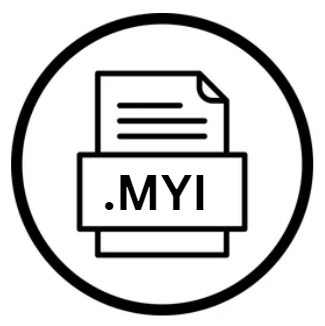.MYI File Extension

MySQL MyISAM Index File
| Developer | Oracle |
| Popularity | |
| Category | Data Files |
| Format | .MYI |
| Cross Platform | Update Soon |
What is an MYI file?
The .MYI file extension stands for MYsql Index, and it’s an integral part of the database system known as MySQL, one of the most popular database management systems in the world.
These files are crucial for the efficient operation of databases as they contain the index information for tables stored in .MYD (MySQL Data) files. The indexes are essential for accelerating the search queries and improving the performance of the database.
More Information.
Initially, the MyISAM storage engine was designed to provide a fast, reliable system for non-transactional databases.
The .MYI files played a crucial role in achieving this performance by storing index data, which allowed for quicker data retrieval and manipulation.
This was particularly beneficial for read-heavy databases where data consistency and transactions were not a primary concern.
Origin Of This File.
The .MYI file is part of the MyISAM storage engine, which was the default storage system for MySQL databases up until version 5.5, after which InnoDB became the default.
MyISAM and its file types, including .MYI, were developed by MySQL AB, a company founded in Sweden in 1995.
The company aimed to provide an efficient, reliable, and easy-to-use database management system, which led to the creation of the MySQL database and its associated file types.
File Structure Technical Specification.
The .MYI file contains the index information for a MyISAM table. It’s structured in a way that allows MySQL to quickly find the rows in the .MYD (data) file corresponding to specific key values.
The structure of a .MYI file can be complex, as it contains various pieces of information such as the number of keys, key type, key length, and the actual key data.
This structure is optimized to ensure that database operations that rely on these indexes, such as SELECT queries or JOIN operations, are executed as efficiently as possible.
How to Convert the File?
Converting a .MYI file essentially means changing the storage engine of a MySQL table. The .MYI file is part of the MyISAM storage engine, and often, database administrators convert MyISAM tables to InnoDB tables for benefits like transaction support and better crash recovery.
This conversion doesn’t involve changing the .MYI file directly but rather altering the structure of the table within MySQL. Here’s how it’s generally done:
- Backup the Database: Always start by creating a backup of your database. This ensures that you can restore your data in case something goes wrong during the conversion process.
- Convert the Table: Use MySQL commands to change the storage engine of the table from MyISAM to InnoDB. This process restructures how the data is stored and managed, effectively removing the need for .MYI files.
- Verify the Conversion: After the conversion, check the table’s status to confirm that it’s now using the InnoDB storage engine. This step ensures that the conversion was successful and the table is functioning as expected.
Advantages And Disadvantages.
Advantages:
- Speed:
.MYIfiles allow for fast read operations, making MyISAM tables particularly efficient for read-heavy applications. - Simplicity: The MyISAM storage engine, and by extension
.MYIfiles, are simple to understand and manage. - Full-text Indexing: MyISAM supports full-text indexing, which is beneficial for quick text searching.
Disadvantages:
- Lack of Transaction Support: Unlike InnoDB, MyISAM (and therefore
.MYIfiles) does not support transactions, which can be a significant drawback for applications requiring data integrity. - Table Locking: MyISAM locks the entire table during write operations, which can lead to performance bottlenecks in write-heavy environments.
- Data Integrity: MyISAM is more prone to data corruption in cases of unexpected shutdowns or crashes compared to transactional storage engines like InnoDB.
How to Open MYI?
Open In Windows
- MySQL Server or Tools: Install MySQL Server or a database management tool like MySQL Workbench or phpMyAdmin.
- Accessing Data: Use SQL queries within these tools to interact with your database. The
.MYIfile will be used automatically by the MyISAM engine to perform operations like searching through indexes.
Open In Linux
- MySQL Installation: Install MySQL using your distribution’s package manager. Tools like
aptfor Ubuntu oryumfor Fedora are commonly used. - Command-Line Interface: Use the
mysqlcommand-line interface to interact with your database. - MyISAM Tools: Linux also offers tools
myisamchkfor checking the integrity and repairing MyISAM tables.
Open In MAC
- Install MySQL: You can download and install MySQL from the official MySQL website or use homebrew to install it.
- Database Management Applications: Use tools like Sequel Pro, MySQL Workbench, or the command-line interface to manage your MySQL databases.













